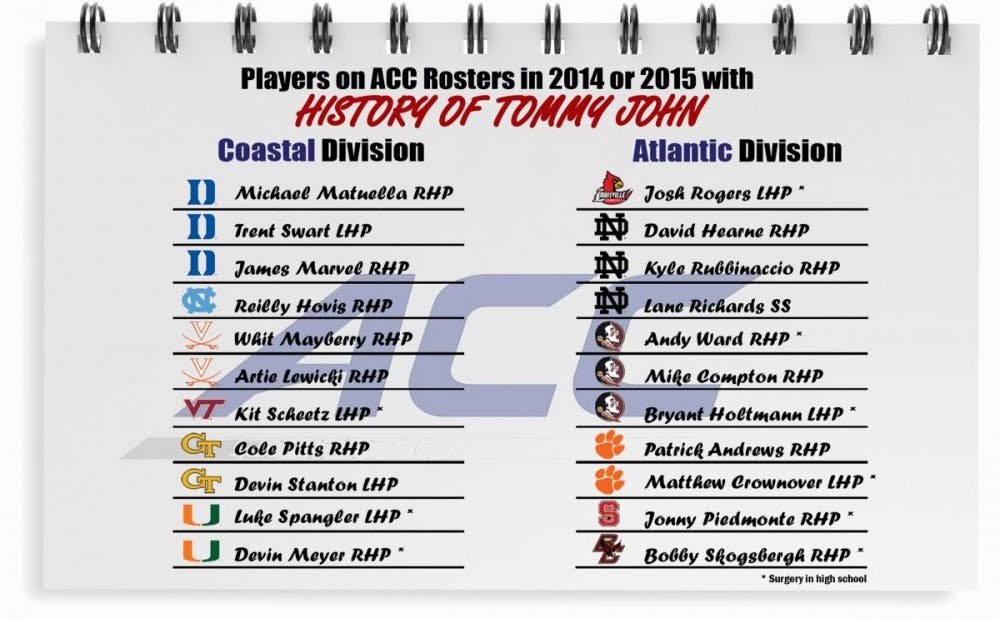With the end of 2015 quickly approaching, The Chronicle's sports department takes a look back at the biggest sports stories of the year. Each day, The Blue Zone will review a major game, event or storyline that helped shape the course of the year in Blue Devil athletics.
Coming in at No. 9 on our list: An in-depth look into the most pressing issue facing the game of baseball today: how to curb the rapid increase in Tommy John surgeries, including operations that put the careers of three Duke pitchers in question.
The elbow injury that has plagued major league baseball players across the country found its way to Durham.
After coaching collegiate baseball for 15 years without a single Tommy John surgery to one of his players, Duke head coach Chris Pollard suddenly had three on his hands in less than a year. The first was James Marvel, who went under the knife in May 2014 after elbow pain became too much for him to continue a promising sophomore campaign.
Next came left-hander Trent Swart, who opted for surgery in December 2014 after what he described a "burning sensation" in his elbow failed to subside despite rest and rehabilitation.
Finally, right-hander Michael Matuella—pegged to be Duke's ace heading into the 2015 campaign—completed the trio when arm troubles cut his junior season short in early April, and he chose to have Tommy John surgery before entering the MLB draft.
The surgery—which is designed to replace a torn ulnar collateral ligament in a pitcher's throwing arm—was first performed in 1974 on former Los Angeles Dodger Tommy John, but has become extremely common in the last decade at both the amateur and professional levels. The Chronicle analyzed the 2014 and 2015 rosters of all 14 ACC schools that compete in baseball, and found at least 22 cases of Tommy John surgery. According to a database maintained by Jon Roegele, the total number of surgeries for major and minor league pitchers has climbed past 1,000.
A number of factors may explain the increase in surgeries. The increasing workload being placed on pitchers at the youth levels is one of the major factors—the culture surrounding college and professional scouting encourages players to specialize in pitching early on in life, throw more innings while playing year-round and throw curveballs and other breaking pitches too soon.
Doctors interviewed by The Chronicle also pointed to improper mechanics by youth pitchers and a tendency to choose surgery to repair a partial ligament tear—rather than wait for a complete tear—as possible explanations.
Ted Sullivan—a former Blue Devil baseball player—has created an app, GameChanger, that enables youth coaches to accurately monitor a player's pitch count to ensure that arms are given enough time to rest. But a fool-proof solution to the Tommy John epidemic remains elusive.
“I’ve got a program that’s 100 percent guaranteed, sure thing that a kid is never going to hurt his arm,” John told The Chronicle in a phone interview. “He doesn’t throw a baseball. But if you’re going to throw a baseball, there’s a chance of getting hurt.”
READ MORE on The Chronicle's coverage of Tommy John:
A national epidemic: Tommy John surgeries at Duke part of broader trend
Duke baseball ace Trent Swart undergoes Tommy John surgery
Duke baseball ace Michael Matuella out for season
Michael Matuella, Sarkis Ohanian drafted on second day of MLB Draft
Check back tomorrow to see what comes in at No. 8 in our countdown of the top Duke sports stories of 2015.
A look at the rest of our top 10 countdown to date:
10. Rebecca Greenwell extends Elizabeth Williams' last dance against Albany
Get The Chronicle straight to your inbox
Signup for our weekly newsletter. Cancel at any time.

